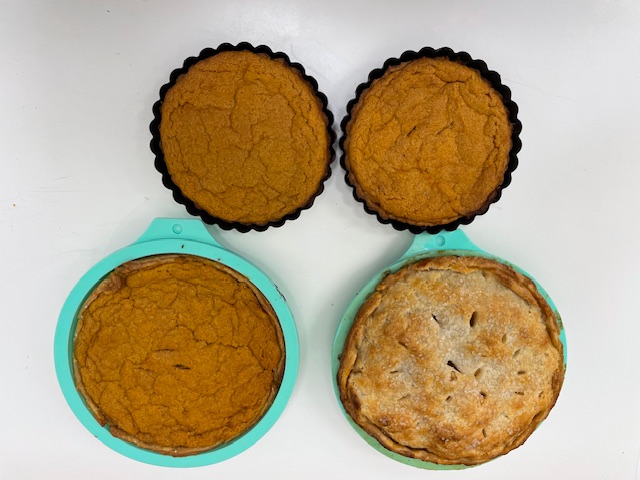Forum Replies Created
-
AuthorPosts
-
I thought the turkey noodle soup came out pretty good, Diane wasn't as fond of it, but she's not a big fan of turkey in general, though she did have two small bowls of it. Making a small batch of semolina noodles brought the carbs up to about 11 grams and 135 calories per 400 gram bowl of soup, which is OK as far as I'm concerned.
November 30, 2024 at 10:22 pm in reply to: What are you Cooking the Week of November 24, 2024? #44818More leftovers here, too, and I'm making turkey stock and will probably make some kind of soup with it tomorrow. I don't know if lupin noodles will hold together in a soup, I may try a little batch of it or just make a small batch of semolina flour noodles, as I don't want the noodles to be the main ingredient in the soup anyway.
November 30, 2024 at 11:31 am in reply to: What are you Baking the Week of November 24, 2024? #44814Len, have you ever tried the folding method for making Kaiser rolls? It takes a little practice but it makes a nice looking roll.
November 29, 2024 at 9:20 pm in reply to: What are you Cooking the Week of November 24, 2024? #44810leftovers here, likely to be rinse-repeat for the next day or two.
I'm sure it'll be repeated on the Food Network.
November 29, 2024 at 10:02 am in reply to: What are you Cooking the Week of November 24, 2024? #44804The upside-down turkey thing worked OK, but the high temperature part didn't seem to work, and I wound up fiddling with the oven temp to get the breast done without overcooking the legs. But it was juicy and tender and easy to slice. I'll probably try it again but at the usual oven temp next time.
I tried stuffing made with keto bread, we decided it was a bit disappointing. Stuffing is something we usually only have once or twice a year, we can afford the carbs from the Pepperidge Farm herbed bread cubes that often.
Diane says the 4" ones didn't have enough filling in them, but the apple pie was nice and thick and I suspect the 6" sweet potato pie will be better than the 4" ones.
November 28, 2024 at 6:52 pm in reply to: What are you Cooking the Week of November 24, 2024? #44795We had turkey, potatoes, stuffing, gravy, green been casserole, baked beans (a dish our guest brought), brussels sprouts, a relish tray, cranberries, popovers, and in a little while will have some of the apple or sweet potato pie for dessert. Diane and our guest are currently working on a jigsaw puzzle, I'm sort of watching the NFL game. I probably won't need to cook again until Monday. I've probably eaten enough carbs that I don't need a lot of carbs until then, too. 🙂
November 28, 2024 at 10:28 am in reply to: What are you Baking the Week of November 24, 2024? #44792Last night I baked a 6" sweet potato pie, 2 4" sweet potato pies and a 6" 'deep dish' apple pie.
Attachments:
You must be logged in to view attached files.It looks like there are 3 episodes of this show airing on Thanksgiving:
8 PM CT Christmas Feast
9 PM CT Christmas Then and Now
10PM CT Christmas Behind The ScenesDo you know which one she's in?
A local baker was in a donut challenge episode on Food Network, the mystery ingredient in the first round was tobacco--ugh! I think she got eliminated in the first round. (Her donut shop didn't survive the Pandemic, either.) She couldn't tell ANYBODY how she did until after the show aired, several months after it was filmed.
November 27, 2024 at 10:47 am in reply to: What are you Cooking the Week of November 24, 2024? #44780Today is kitchen clean-up day, I've cleaned the stove top and both ovens, my wife is working on other parts of the kitchen including her bay window plant shelf and I will organize the baking area a bit too, so I've got work space for doing Thanksgiving.
Today I will also dry brine the turkey and get it ready for final prep tomorrow. This afternoon I'll bake a sweet potato and make small pies for Thanksgiving, apple and sweet potato. That should take me well into the evening. Dinner is likely to be something simple, like tomato soup and cheese sandwiches.
I made lower-carb pie dough for 3 six-inch tarts and a top for one of them. I'm planning to make an apple pie/tart and one or two sweet potato pies, depending on how much filling the first one will hold. (I might freeze one of them before baking it, that's supposed to work with this recipe.)
November 26, 2024 at 7:13 pm in reply to: What are you Cooking the Week of November 24, 2024? #44777We had smoked pork chops.
Too bad, she always had interesting things to talk about, but thanks for sending her that recipe.
The group here is shrinking slowly, not many new active posters. The good news, though, is Google says traffic from non-members browsing is trending up. This time of year the two Blog posts I wrote about pie dough thickness get a lot of hits, but they get hits all year long.
November 25, 2024 at 7:53 pm in reply to: What are you Cooking the Week of November 24, 2024? #44763We had a rotisserie chicken from Sams tonight.
-
AuthorPosts
